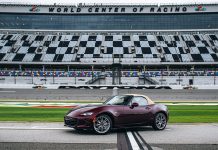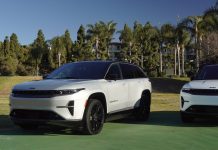For the second year, Optima has set up a charging station in the desert.
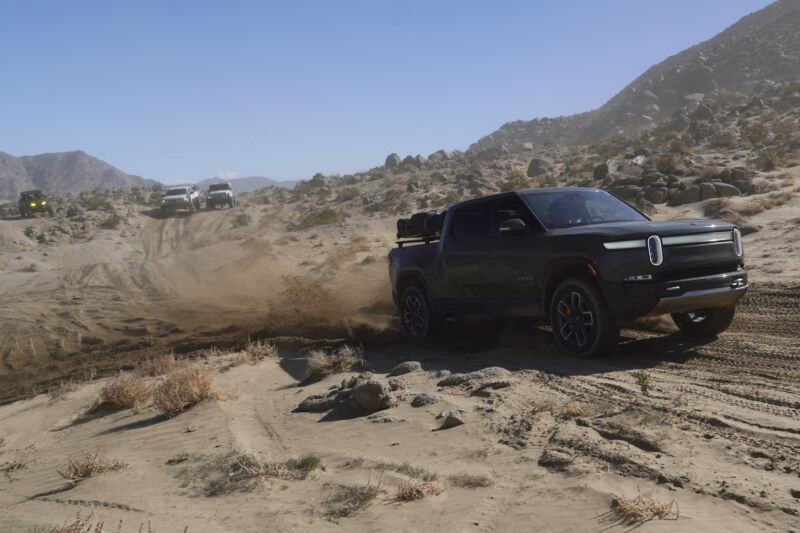
Electric vehicles are few and far between in the desert at King of the Hammers, a weeks-long off-roading event that often looks more like Burning Man than motorsport. Almost all EVs can be found at the Optima Oasis, a not-so-literal oasis of solar and hydrogen-powered chargers that the battery company erected smack-dab in the middle of nowhere for the past two years.
King of the Hammers takes place in Johnson Valley Off-Highway Vehicle Area, the nation’s largest OHV space by sheer acreage. But the vast expanse, about 100 miles as the crow flies from downtown Los Angeles, turns into a thriving metropolis once a year when a makeshift city dubbed “Hammertown” draws tens of thousands of four-wheeling enthusiasts to the sand and rocks.
I went to check out the festivities—especially the event’s EV-focused Unplugged rally.
Slow charging at King of the Hammers
This year’s attendance peaked at over 100,000, but that full number wasn’t quite present when I drove out on KoH’s first Sunday in an Audi Q8 e-tron to watch trophy trucks race at top speed across the desert. Range anxiety kicked in heavily on my 135-mile (217 km) commute, which included a few thousand vertical feet of climbing to truly test the Audi’s claimed 280 miles (450 km) of electric range.
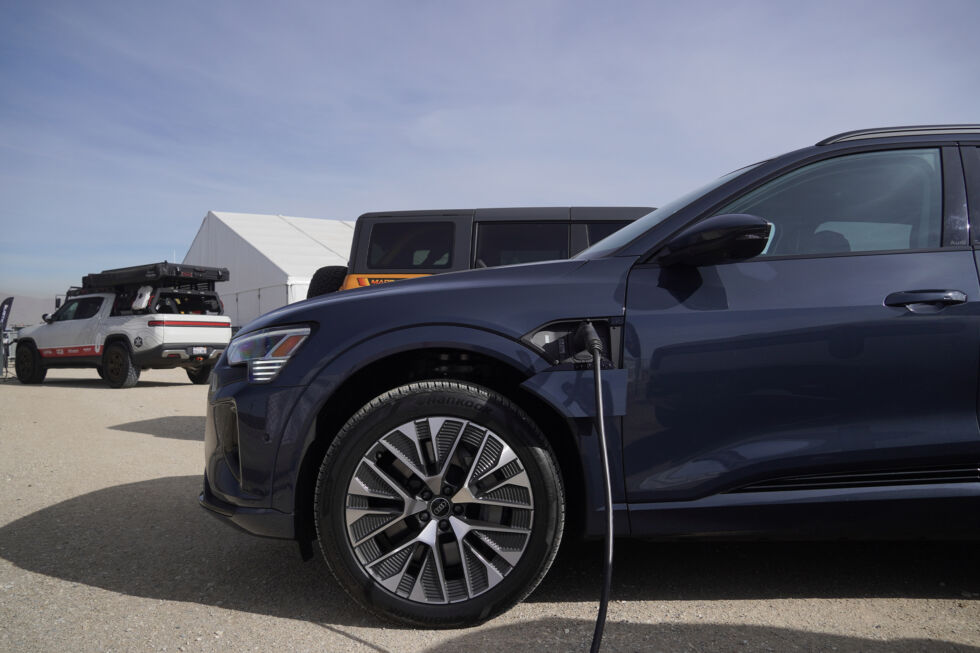
I arrived at the Optima Oasis with 78 miles (126 km) of range remaining and promptly plugged into a Level 2 charger, where I left the Audi charging for the rest of the day. I checked in a few times, noting that the charger, hooked into the KoH grid, managed to pump out an average of about 12 miles (19 km) worth of electrons per hour. At approximately 50 kilowatts, that rate would be enough to get me home later in the evening, but not if I’d been out four-wheeling in the car all day—and that slow rate certainly wouldn’t do the trick for the massive group of EVs that Optima expected later in the week as part of its second Unplugged rally. As the sun went down and I readied myself for the drive home, three massive tractor-trailers arrived with the solar and hydrogen setups to support EV owners for King of the Hammers’ main events.Advertisement
The following Thursday, I drove back to Johnson Valley in a Ford Bronco Raptor, probably the greatest production vehicle ever built for the desert—if not the most fuel-efficient or eco-friendly. I planned to catch the home-built Every Man Challenge, as well as the most hardcore half-million-dollar-plus Ultra4 race that serves as the main event on the second Saturday. But first, I sheepishly pulled my gas guzzler back into the Optima Oasis to join a growing group of EV enthusiasts milling about the charging stations.
The sun began to warm us, the cars, and two massive solar arrays as more and more EVs pulled in—far more than I expected at an event that tilts heavily toward the joys of internal combustion. We’d definitely need faster chargers than I used on the Audi, I thought. Many owners topped up their batteries, while a team from Morrflate gave out lessons on airing down tires for better traction, a more comfortable ride, and reduced risk of flats while off-roading.

And we needed that lesson, as Optima also chose a much more technical route than I expected—especially considering the smattering of bone-stock Kia and Toyota crossovers throughout the group, some of which wore eco tires or little more than all-seasons. But Rivian R1T and R1S owners made up the majority, and most of the vehicles still rode on factory Pirelli Scorpion All-Terrains. Optima allows plug-in hybrids into the Unplugged rally, too, and I spotted a few Jeep Wrangler 4xes and Toyota Tundra hybrids, plus one Cybertruck brought out for testing by Unplugged Performance.
I’m paranoid, and the weather forecast predicted heavy rain, so I packed my recovery gear and threw in a set of Maxtrax Lite recovery boards, a Yankum rope, and two soft shackles into the back of my borrowed R1T before we left Optima’s home base for the trail run. And not just for the “soft-roader” hybrids—also because I’d never actually driven a Rivian before and didn’t quite know what to expect.
First time off-roading, or even driving, a Rivian R1T
Luckily, the weather forecast proved entirely inaccurate. Instead of a torrential downpour, bright blue skies and a crisp breeze created ideal conditions for a romp around the desert. In my passenger seat rode Rivian engineer and Pikes Peak International Hillclimb record-holder Gardner Nichols, ready to coach me through any sticky situations and equally stoked by the turnout of EVs for our adventure.
- There were more than just Rivians in attendance. Michael Teo Van Runkle
- But there were quite a lot of Rivians. Michael Teo Van Runkle
- Out on the trail. Michael Teo Van Runkle

“Optima has a great relationship with Rivian owners around the country, so it’s cool that they have access to the chargers and then the capability to put on an event like this,” Nichols told me. “There’s not one person here who absentmindedly bought a Rivian, which is awesome. Everyone is really stoked on their Rivian and wanted to outfit it with their own accessories or some aftermarket wheel-tire setups, or even make their own accessories.”
As Nichols walked me through the R1T’s various drive modes as dictated by the terrain, I kept an eye on the other EV and hybrid owners. Many stayed in line and steadily cruised through sandy ruts and over some remaining mud from a previous storm. Everyone maintained a solid pace during some rocky ledges and boulder fields. But others pushed harder, truly exploring the capabilities of electric torque outside the constraints of the typical city driving that most minds think of as ideal for EVs.
A Ford Lightning, on city-slicker all-season tires, occasionally struggled due to its long wheelbase and independent rear suspension. But a Kia EV9 charged hard up a steep shelf with a tire up in the air more than once, then got down and dirty spinning donuts in the dunes. One of the Toyota crossovers lost a few pieces of body cladding in the rocks, but the owner helpfully offered to lend the vehicle for a little demonstration of how to use the new Maxtrax Lite recovery boards. I used one as a shovel to dig a little hole in the sand, then we dipped the front wheel in there until it spun a bit. I dug out a couple more scoops, popped the Maxtrax into place, and the hybrid simply climbed right back out. Not bad for a humble city commuter!Advertisement
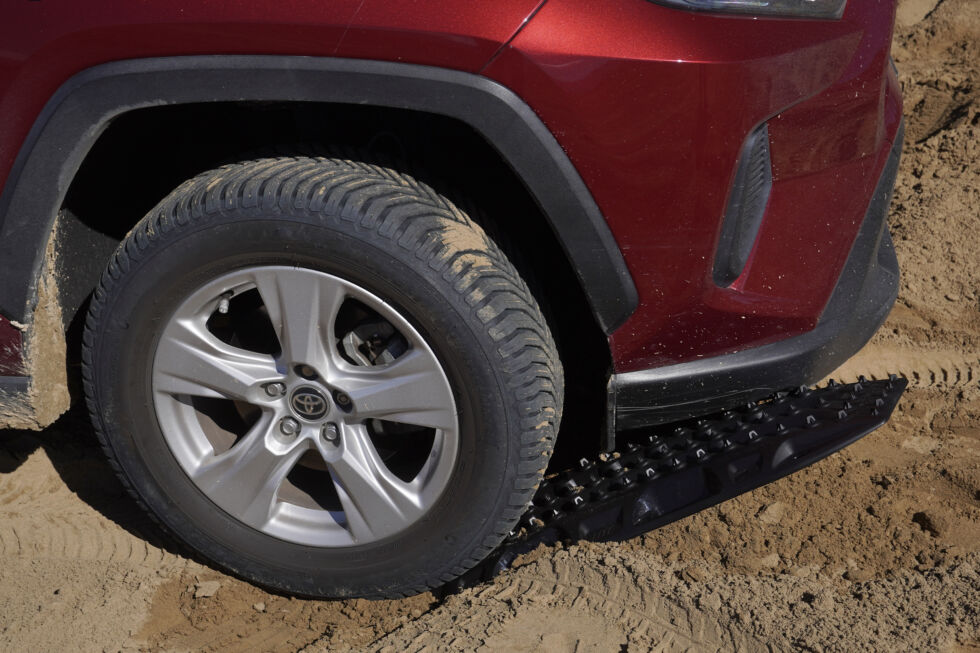
“Off-roading an EV is super unique and just a pleasure,” Nichols told me as we rolled back, “If you’re cruising around with the windows open, you hear the rocks crunching under your tires and the sand sort of moving around. That’s something that maybe you don’t necessarily get in a Jeep or a Bronco quite as much.”
A closer look at the Optima Oasis charging setup
Back at the Optima Oasis, I took the time to check out the charging setup that had sprouted since my first day out at King of the Hammers. Renewable Innovations IS Administrator Larry Bendall walked me around all three Mobile Energy Command Center (MECC) trailers, pointing out the details that less inquisitive eyes might take for granted.
The eye-catching solar arrays, which Bendall called “flowers,” were each made up of 12 individual 300 W panels. As day breaks, the flowers automatically unfold and track the sun, then close back up at sunset. The trailer’s central shipping container also holds two rigid rectangular arrays, as well as 12 battery stacks capable of storing 18.5 kW each, plus four inverters. Down on the ground, the whole system powers four Level 3 chargers and can push 50 kW of charge into four EVs at the same time.
For faster charging, Bendall directed EV owners in a rush to the MECC-Hydrogen trailer’s rear door. There, two fast chargers can charge most vehicles from empty to 80 percent in about a half-hour thanks to eight 30 kW fuel cells that combine to produce a quarter of a megawatt of power. Two strings of 390 V batteries store the energy, which onboard inverters can convert to AC.

The second MECC-H requires Renewable Innovations’ third trailer, a 40-foot container that houses 1,763 lbs (800 kg ) of compressed hydrogen. Steam clouds billowed from the fuel cells of the MECC-H all day and night at King of the Hammers as the fuel cells sucked oxygen out of the air to combine with the stored hydrogen, performing reverse electrolysis that results in heat, water, and precious electricity. That power then eventually flowed through the two 250 kW fast chargers into the Rivians, Toyotas, Kias, and Jeeps at the Optima Oasis.
In total, the MECC-S trailer weighs a whopping 68,000 lbs (30,844 kg), while the MECC-H trailer tips the scales at 74,000 lbs (33,566 kg). The whole setup definitely works, but Bendall acknowledged that Renewable Innovations’ next project involves shrinking the components into a smaller contained unit comprising a single fuel cell, a hydrogen tank, and batteries that can recharge 10 cars before needing more hydrogen.
Weight considerations while off-roading
While the EV owners took turns charging at the Optima Oasis, Nichols and I jumped back into the Bronco Raptor to take in the rest of Hammertown and the surrounding desert. After the Rivian R1T, which weighs over 7,000 lbs (3,175 kg) in quad-motor form—before bolting on rails and a roof tent—the Braptor, at just shy of 6,000 lbs (2,722 kg), seemed downright nimble. Of course, those 37-inch tires (aired down to 22 psi) and massive Fox 3.0 LiveValve shocks contributed to my sensation of driving essentially a gigantic side-by-side with over 400 hp (300 kW). Jumping over whoops and sliding across the lakebed at top speed, I thought aloud about how the consideration of battery weight still limits the potential fun of serious four-wheeling.
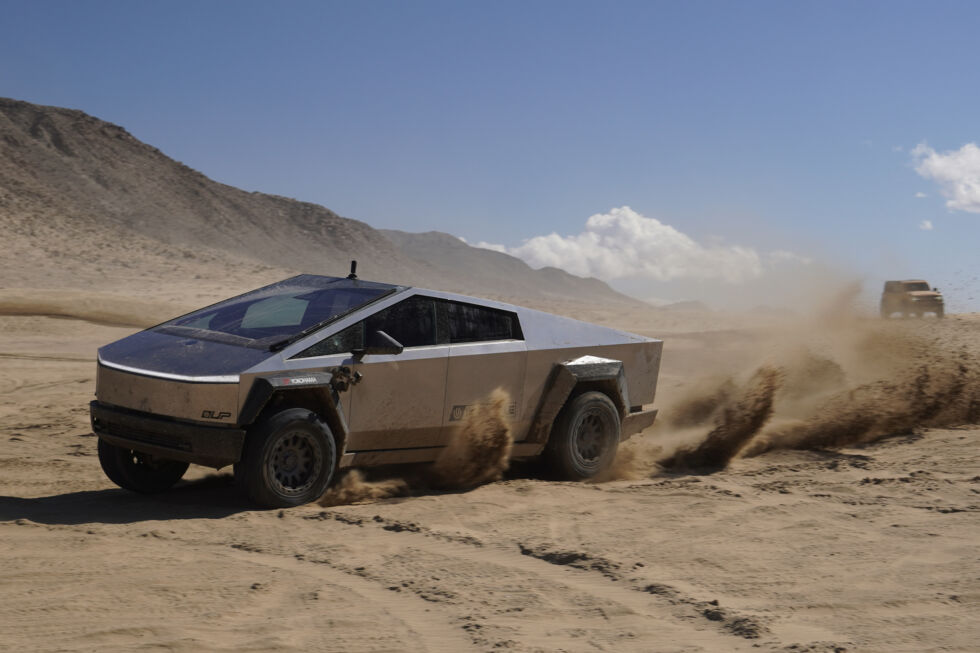
Later in the weekend, that same Cybertruck would shear a rear toe link and end up stranded, requiring some MacGyvering with a ratchet strap and even driving in reverse to get back to civilization. Did the dune-buggy donuts in a truck that weighs more than three tons over-stress the rear-wheel steering system? Probably, though I wasn’t present when the breakdown occurred.Advertisement
But I mentioned to Nichols that the prospect of real rock-crawling—what King of the Hammers is known for since the Hammers are a series of unbelievably difficult rocky canyon obstacles—actually provides a better use case for EV off-roaders than perhaps higher-speed four-wheeling. All that low-end torque, discretely programmable traction control systems, and minimal distance traveled might mean that an electric rock-crawler could stay lightweight, with plenty of power to climb up gnarly trails.
“I think as far as power delivery and precision, Rivian and other EVs have definitely shown the capability,” Nichols said. “As a driver, you just get this instant torque delivery, and it’s easier to be really precise with your off-roading. It might even open rock crawling up to more ability levels, I would say, because the technique is much easier to grasp than maybe doing the same obstacle in an ICE vehicle, whether it’s a stock Jeep or a side-by-side or some of these crazy Ultra4 cars.”
Then again, even while rollicking around in the Rivian, the total distance traveled while off-roading can easily seem similar to seeing a mirage in the desert distance. I tracked the Optima Unplugged rally using my OnX Offroad app, which showed that during more than a few hours of exploring, we covered just 20 miles in total. At an average speed of 9 mph, the Rivian used 18.6 kWh of charge—not enough to prevent Nichols from topping up on just one of the slow chargers before heading home for the night.
But despite the good EV turnout, the focus was still on vehicles like the Braptor, which elicited cheers while ripping around, constantly shooting rooster-tails and catching air. In that regard, the Optima Oasis still has some work to do in attempting to drive EV adoption among the larger off-roading community.

